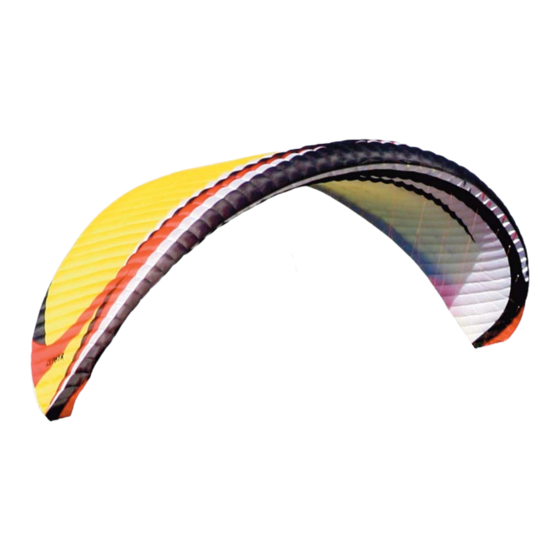
Advertisement
Quick Links
Advertisement

Summary of Contents for WINDTECH ZEPHYR Series
- Page 1 m a n u a l Z E P H Y R...
-
Page 3: Flight Manual
Windtech w w w . w i n d t e c h . e s Z E P H Y R X S - S - M - L flight manual... - Page 4 > index > congratulations ––––––––––––––––––––––––––––––– > warning & liability ––––––––––––––––––––––––––––– > construction & materials ––––––––––––––––––––––– > certification –––––––––––––––––––––––––––––––––– > best glide –––––––––––––––––––––––––––––––––––– > flight ––––––––––––––––––––––––––––––––––––––– ––––––––––––––––––––––––––––––––––––– -- launch –––––––––––––––––––––––––––––––––– -- strong wind > thermal flying –––––––––––––––––––––––––––––––– > flying in turbulence ––––––––––––––––––––––––––––...
- Page 5 We appreciate your feedback, so please send us your comments, positive or negative, in regard to the range. Windtech You are the best feedback and support for future products, and please remember that we are always happy to give you any help and advice. best winds > Windtech team...
- Page 6 Windtech taken a training course, and has the suitable ability and enough experience to safely fly the ZEPHYR.
- Page 7 are made with stronger (slighly heavier grade) nylon of to prevent aerofoil deformation, even after several years of intensive use. Rib (cell wall) reinforcements are made of Dacron 310- gr. Line attachment points are made of polyester. --lines The lines are made of Superaramid kevlar covered with a polyester sheath for protection against wear, UV and abrasion.
- Page 8 -With around +25 km/h of head wind, best glide is obtained with 75-100 accelerator. When flying downwind (wind from behind) the best glide is obtained between 0% brake and 10% of brake. The ZEPHYR is a EN level accelerated but using the accelerator system close to the ground is not advisable and it should be released as soon as turbulent air is encountered.
-
Page 9: Flying In Turbulence
-- launch Choose an open space free of any obstacles, especially trees and power lines. Open your glider in a slight horseshoe arc (semi-circle) and thoroughly check that you have no knots or line twists. Make sure your helmet is securely fastened and clip into your harness making sure all straps are securely fastened. - Page 10 If you progress at a nice steady rate, and keep safe, you will find thermal flying will become a pleasure. With qualified instruction you will actually learn faster, learning how to optimise your thermal skills. A safety (SIV) course is something to consider, as these teach you how to deal correctly with unstable situations such as collapses, rapid descent manoeuvres, stalls ands spins, and so you will get far more from your flying.
- Page 11 er paraglider and being 'waked' by the wing tip vortices of the glider and turbulence wake turbulence of the pilot. Remember, the pilot can learn to help stop collapses by flying 'actively', but if a front tuck does occur it will easily clear itself. Re-inflating the wing can be helped by correct pilot input and, once the glider is overhead, symmetrically applying 40 % of both brakes and then releasing immediately will get pressure back in to the glider and speed up the recovery.
- Page 12 > weather to fly If in doubt whatosoever about the weather and flying conditions, then do not launch! Before going flying you should check the weather forecast and always ask more experi- enced pilots about the conditions expected for the day. Never fly if there weather con- ditions are unsuitable, especially with any of the following present or even threatening: Strong wind;...
- Page 13 enter a spin in this way. Ease off on the inside brake, and weight-shift less hard, to regain level flight. Like this, the pilot can control the bank angle and the sink rate of the glider in the Spiral dive. Always remember that whilst in the Spiral dive you are drifting with the wind, and it is very easy to become disorientated.
-
Page 14: Maintenance
We strongly recommend you to have a full inspection of the paraglider by or the Windtech distributor at least once a year. Besides this you should check periodically the lines, cloth and stitching. Every 150hrs. or once a year, which ever comes first, change all bottom lines. This is very important to maintain the flying and safety characteristics of the wing. - Page 15 Z E P H Y R | technical specifications | Size 24.67 26.45 28.4 30.6 Area (m 21.63 23.19 24.9 26.83 Projected area (m 11.55 11.96 12.86 12.39 Span (m) 9.73 10.08 10.47 Project. span (m) Aspect ratio 4.08 4.08 4.08 4.08 Project.
- Page 17 Z E P H Y R X S - S - M - L...
- Page 18 ç ç A=435 mm B=460 mm =525 mm C=525 mm D=525 mm...
- Page 19 Z E P H Y R | flight log | size date site duration flight details...
- Page 20 · 7 33201 g i j ó n spain | p.o. box · 269 33280 | p# · +34 985 357 696 | fax · +34 985 340 778 | email · info@windtech.es | web · www.windtech.es POWERED BY WINDTECH...

Need help?
Do you have a question about the ZEPHYR Series and is the answer not in the manual?
Questions and answers